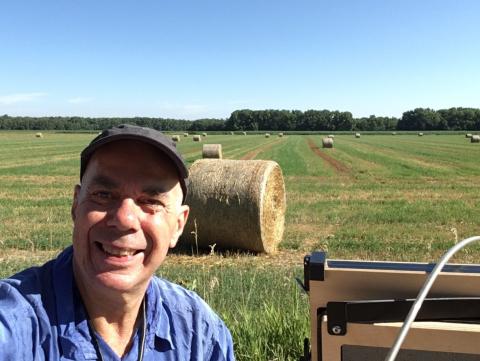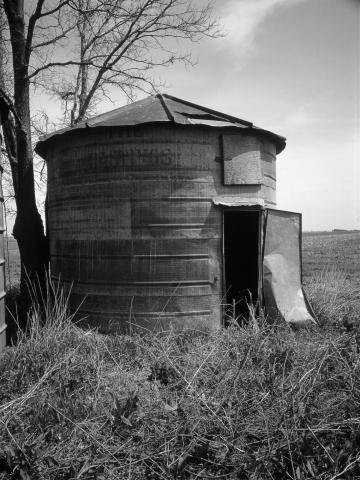

2019 Artist-in-Residence, Richard Dickson, On What Inspires His Rural Photography
Richard Dickson, an English photographer, has been in residence with the National Willa Cather Center since early July to photograph the landscapes and buildings in and around Red Cloud and Webster County. Using Victorian-era and traditional photographic processes while here, his current work is inspired by Willa Cather's writings and the land which she loved. His photographs taken this summer will be featured in his forthcoming exhibit, Beauty in the Ordinary, at the Red Cloud Opera House Gallery (from August 9 - September 30, 2019). We recently asked him some questions about his photography and his summer residency.
Tell us a bit about you and your photography?
I’m from London, England and photography has been a passion of mine since I was seven when my mother bought me my first camera; I still have some photographs taken then. It is only in the last several years that I have spent more time on it entering competitions and open calls with a lot of success and I have been able to organize and categorize my images. I have an interest in the world about me and have always been a keen observer so photography has been a creative outlet for me to express that. I am interested in the whole process of assessing the scene, taking in whatever attracted me to it, and the creative procedure to final print and display. To this end, I have also been exploring alternative processes using early photographic methods, camera-less techniques, and different materials and chemical processes — each giving a unique expression.
What brought you to Red Cloud this summer?
A few years ago I visited New Mexico, attracted by the sights and the setting of the artists who settled there. On my return, a colleague lent me Death Comes for the Archbishop and I was immediately struck by how Willa Cather's descriptions matched the scenes I saw and recorded perfectly. So I learned about Cather and sought out her other works, contacted the Foundation, and on a return visit to New Mexico last year dropped by Red Cloud and had a meeting with executive director Ashley Olson who offered me this residency.
Do you have a particular favorite work of Willa Cather or something from her writing that inspires your photography residency here?
I was taken first by her descriptions of not only the land but also the people in Death Comes for the Archbishop. The scenes and people she has set in the novels based around Red Cloud also gave me an urge to see for myself the land and imagine what it was like in those days. The land, the prairie, the vegetation and isolated homesteads, and the hard work and social fabric have been the things that have been in my mind. Her observational and descriptive powers create a lasting and firm impression of the area and travelling around it, it all comes to life.
In general, how does landscape, setting, and rural architecture inspire your photography?
I am interested in how we humans adapt and live in a particular place; how we have to work with nature and how we change the environment to do the things we need to survive. All of that provides a rich contrast of the natural environment and say, for instance, the large farm plots, and especially the machinery like the grain silo plants which I find fascinating — like cathedrals of the land.
Are you drawn equally to rural and urban settings? Why or why not?
Rural or urban there is still that element of how we fit in. With urban, of course, it is more a manufactured setting, at least a densely developed setting that is entirely of our making but we still have to find ourselves within that.
What draws you to a particular image to photograph it?
It is a very quick process and I cannot say what particularly might attract me to a scene. It may be something to do with the play of light, texture, contrasting objects, colors; it is an almost immediate response to something or a moment and, as such, I find myself working quickly, sometimes too quickly, to try to capture that before the light or situation changes. Just being observant makes something catch my eye.
Is there a photographic medium/process that your prefer to use? Tell us a bit about that.
I use film in all formats, gradually going up the range to the 8x10 view camera I have used to create the images here. I like the whole process — it makes you slow down a little, really, to get the composition. In colour I shoot mostly transparencies because there is nothing like developing the film and seeing the image appear and hold it in your hand. To see an 8x10 inch color slide is a complete “wow.” Actually, with every image I produce like that I am always wowed. When I make a black and white print I have the same response: there is something magical about it seeing the image appear before your eyes and to be able to physically grasp it and examine it from all angles. The chemical processes also allow for creative control that I prefer over digital. I do scan color film and often have prints made from the digital file but still use archival chemical processes. I prefer the palette and smooth gradations of film, and with black and white you have many variables you can control to affect the final image. For this residency, because of the need to produce work immediately for exhibition, I used early photographic processes, hand coating paper and contact printing the negative, or used a special paper in the camera that develops to a positive print, and even camera-less techniques.
How would you say rural and urban settings in England and America differ — and how are they similar? Would you say there is a greater appreciation of those boundaries in England than here? In general, but also in terms of your wanting to photograph them.
The major difference with both rural and urban settings between the two countries is one of scale. Everything in England is more compact, whereas here there is a vastness and open space even in the towns. Apart from that there is little difference. For instance, Red Cloud at first reminded me of the village in England my brother lives in, just that over there everything is compressed into a smaller space. I’ve not really considered boundaries as such; again it is just a sense of scale.
Do you find a general disdain for “machines in the garden” on English farms as there can be with rural “detritus” or rusted metal “junk” here (although it seems more appreciated now than before)? Does it make it even more appealing to photograph or document?
I’m not connected with farms in England so would not really know. I do recall when, as a teenager, we lived on the edge of a small town and were surrounded by farms and travelling out into the country I would often come across old machinery, and much of that is appreciated to a certain crowd. I don’t think there is any disdain: an indifference perhaps. Certainly, I like it for its history and engineering.
Who are some photographers that inspire your work?
Over the years there have been many photographers I have liked. Josef Koudelka is one that has always stuck in my mind from an exhibition I saw many years ago of his works in rural Czechoslovakia. Recently, I have been inspired by the works and life of Sally Mann who spent hours crafting prints and said something like, “You don’t have a photograph until you have a print.” She also uses different materials and imperfections are often part of the image. Another photographer I recently saw an exhibition of is Wolfgang Tillmans who uses a lot of different materials and techniques. I am attracted to those types of image-making and am exploring more of that type of creative technique.
What has surprised you the most about Red Cloud or rural Nebraska? Or least surprised you?
I think that Red Cloud, for a small town, surprised me as being busier than I thought it might be. Staying at the Burlington Depot I have been fascinated by the machinations of the grain plant, the constant truck traffic, and even witnessed an enormous wagon load hauled by train. In fact, the number of rail lines and the fact they are still used surprised me. And the countryside itself, certainly in these parts, actually reminds me of the county of Suffolk in England – large fields, gently rolling land, rivers bounded by groves of trees, grazing land and meadows; more varied and not quite what I was expecting. I took a selfie in front of a field of hay bales and it could have been anywhere in England.
What do you plan to do next after your residency?
After the residency it is back to my day job as a physical and movement therapist. This has given me the opportunity to pursue and explore my photography unhindered and was a great break away from quite intense work in my other career. There is an open call coming up and I have learned about other artist-in-residence opportunities.
+ + +
You can learn more about Richard Dickson and his work on his website at www.ipercept.co.uk. You can meet him at the opening reception and lecture for Beauty in the Ordinary on August 9 at 5:00 p.m. and find out more about the exhibit here.
